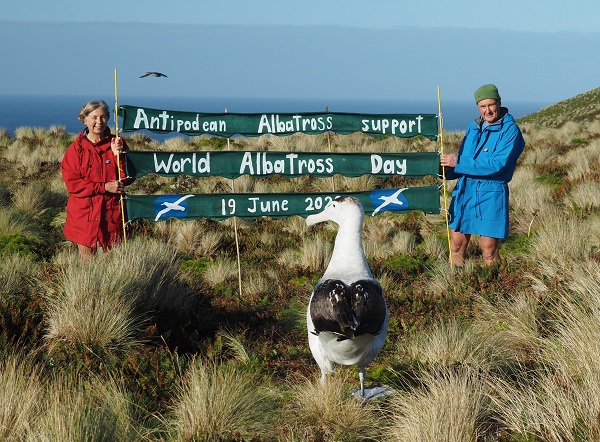
A colour-banded Antipodean Albatross on Antipodes Island, photograph by Kath Walker
Graeme Elliott & Kath Walker (Department of Conservation, New Zealand) have reported to the Department's Conservation Service Programme on their most recent field trip to study globally Endangered and Nationally Critical Antipodean Albatrosses Diomedea antipodensis on Antipodes Island.
The report’s abstract follows:
“The Antipodean wandering albatross Diomedea antipodensis antipodensis has been in decline since 2007. The decline appears to be driven in large part by high female mortality, though reduced breeding success and increased recruitment age have exacerbated the problem.
Difficulty reaching Antipodes Island in the 2019/20 summer meant field studies were undertaken much later than usual, and the COVID-19 pandemic meant less than two weeks was spent on Antipodes Island, from 15–28 March 2020. As a result, assessment of 2019 nesting success (59%) was a little coarser than previously and the chicks had all fledged before we arrived to band them. It also meant that birds which visited Antipodes Island to breed but failed early, or which left the island early after failing to find their usual breeding partner, were not recorded. This included birds wearing satellite transmitters in 2019 whose survival after their transmitters stopped working could not be verified.
Only 75 pairs nested in the study area in 2020, amongst the lowest recorded, but female survival in 2019 had increased over previous years, at least amongst non-breeding females. Breeding female survivorship in 2019 was at an unsustainable 74%, though this estimate was likely affected by the late timing of Antipodes Island fieldwork in 2020. There is so far, no evidence of the sustained improvement in female survival necessary for the population to recover.
Since 2009 there has been an estimated 1,000 “extra” deaths per year of adult albatrosses over and above their normal mortality, and if the mortality rate amongst younger pre-breeding birds is similar, then approximately 1,300 “extra” deaths per annum also occurred amongst younger birds. This suggests that since 2004 about 15,000 “extra” adults have died, and about 20,000 “extra” pre-breeding birds, of which about 70% have been female.
Forty satellite transmitters were deployed in mid-March 2020, 25 on females (10 breeding) and 15 on males (7 breeding). Half were battery-powered and the remaining 20 transmitters were solar-powered. Most of the birds were adults which had bred before, but nine were relatively young female pre-breeders (7–11 years old). This deployment aims to identify fishing fleets with high levels of spatial and temporal overlap with Antipodean wandering albatrosses in 2020.”

Kath Walker and Graeme Elliott on Antipodes Island, with a curious Antipodean Albatross
Reference:
Elliott, G. & Walker, K. 2020. Antipodean wandering albatross: satellite tracking and population study Antipodes Island 2020. Wellington: Conservation Services Programme, Department of Conservation. 54 pp.
John Cooper, ACAP Information Officer, 14 October 2020

 English
English  Français
Français  Español
Español